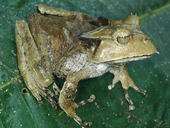|
Hemiphractus helioi Sheil & Mendelson, 2001
| family: Hemiphractidae genus: Hemiphractus |
 © 2013 Alessandro Catenazzi (1 of 2) |
|
|
|
Description SVL of holotype is 52.7 mm, nostrils ovoid, slightly protuberant, projecting dorsally, slightly laterally; lips not flared. Interorbital region is 30% of head width, eye diameter is 22% of head width. Tympanum is vertically ovoid. Mandible bearing serrations along entire length of lower jaw with 2 prominent tusk-like projections from mentomeckelian bones. Fingers are long and fairly robust, relative finger lengths are 3>1=4>2. Webbing on hands is relatively thick. Tibio-tarsal articulation reaches tip of snout when hindlmbs are adpressed anteriorly. Relative lengths of toes are 4>3=5>1=2. Cloacal opening is directed posteroventrally at midlevel of thigh. Dorsum and flanks have very small granules. Distribution and Habitat Country distribution from AmphibiaWeb's database: Colombia, Ecuador, Peru
Life History, Abundance, Activity, and Special Behaviors Possible reasons for amphibian decline General habitat alteration and loss
References
Sheil, C. A., and Mendelson, J.R. III (2001). ''A new species of Hemiphractus (Anura: Hylidae: Hemiphractinae), and a redescription of H. johnsoni.'' Herpetologica, 57(2), 189-202. Trueb, L. (1974). ''Systematic relationships of neotropical horned frogs, genus Hemiphractus (Anura: Hylidae).'' Occasional Papers of the Museum of Natural History, University of Kansas, 29, 1-60. Originally submitted by: Raul E. Diaz (first posted 2004-06-04) Edited by: Tate Tunstall (2004-08-18) Species Account Citation: AmphibiaWeb 2004 Hemiphractus helioi <https://amphibiaweb.org/species/5831> University of California, Berkeley, CA, USA. Accessed Nov 12, 2024.
Feedback or comments about this page.
Citation: AmphibiaWeb. 2024. <https://amphibiaweb.org> University of California, Berkeley, CA, USA. Accessed 12 Nov 2024. AmphibiaWeb's policy on data use. |



 Map of Life
Map of Life